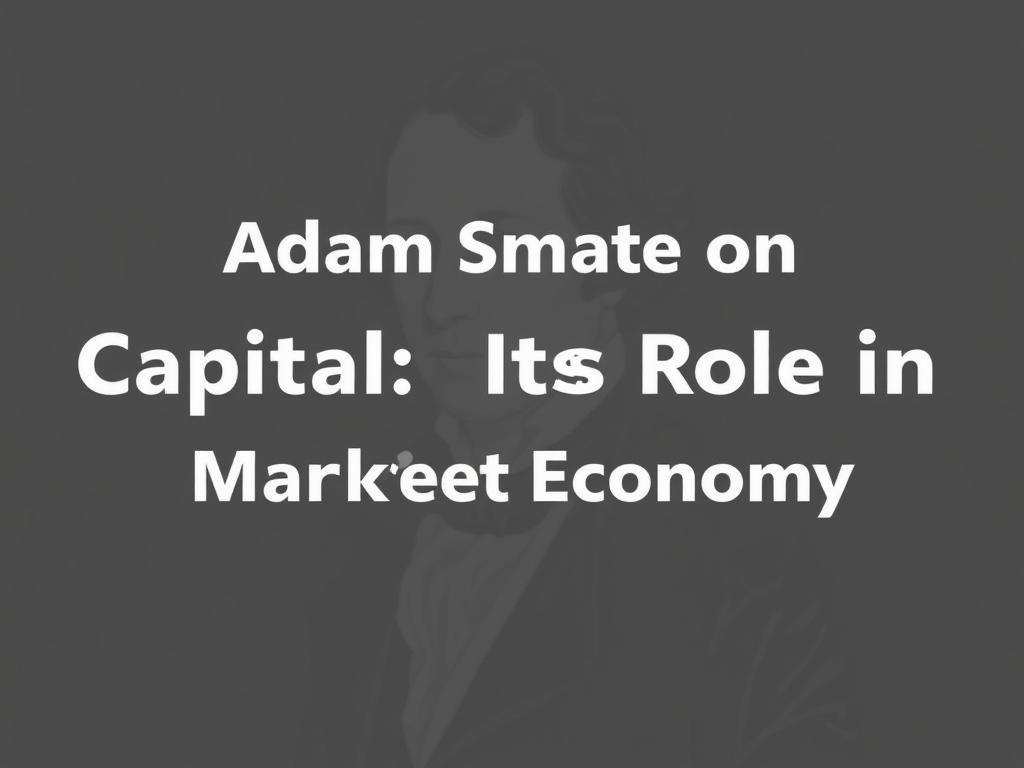Adam Smith on Capital: Its Role in a Market Economy
Adam Smith, often hailed as the father of modern economics, provided foundational insights into how capital functions within a market economy. His perspectives, articulated primarily in “The Wealth of Nations,” continue to influence how we think about the flow of money, investment, and production today. Understanding Adam Smith on capital means appreciating the critical role of capital as a driver of economic growth and the mechanism through which resources are allocated efficiently in a competitive market. For anyone curious about how economies grow and how individuals interact in markets, exploiting capital’s potential is a topic worth unpacking carefully.
At the core of Adam Smith’s views is the idea that capital is not just money sitting idle—it represents the tools, machinery, and resources that enable labor to be productive. This concept highlights the intertwined relationship between capital and labor. Smith argued that capital accumulation allows businesses to hire more workers, invest in better equipment, and improve productivity. This process, in turn, fuels the expansion of markets, increasing the supply of goods and services while lowering prices for consumers. By framing capital as a catalyst within the market economy, Smith laid the groundwork for understanding economic growth as an outcome of investment and innovation.
The Nature of Capital According to Adam Smith
Smith distinguished capital from land and labor by emphasizing its unique function in production. While land provides natural resources and labor contributes human effort, capital is essentially the stock of wealth used to produce goods and services. More specifically, he considered capital to be wealth employed in trade or business to generate profit, rather than wealth held for mere luxury or personal use. To grasp Adam Smith on capital, we must recognize this productive role—it’s not just about having wealth; it’s about using that wealth wisely to create more value.
This differentiation allows us to explore how capital works within a market economy. Smith divided capital into fixed capital (like machinery and buildings) and circulating capital (such as raw materials and wages). Fixed capital helps maintain ongoing production processes, while circulating capital moves through short-term cycles to sustain daily operations. This classification offers us insight into the intricate system of investment and expenditure that underlies any successful market economy.
Capital Accumulation and Market Growth
One of the most vital contributions Adam Smith made regarding capital is his analysis of capital accumulation’s impact on market expansion. By saving and reinvesting profits—as opposed to consuming them outright—business owners can increase their capital stock. This continuous cycle leads to more production, job creation, and higher economic output.
To illustrate:
| Capital Type | Function | Example |
|---|---|---|
| Fixed Capital | Supports long-term production | Factories, machinery |
| Circulating Capital | Used in short-term production processes | Raw materials, wages |
In his view, the more capital an economy accumulates, the greater its capacity to specialize labor and innovate. This specialization—another core Adam Smith concept—drives productivity gains and fosters a competitive environment where businesses strive to optimize resource use. Thus, capital acts both as a foundation and a lubricant for the functioning of a market economy.
The Role of Capital in Facilitating Free Markets

Adam Smith famously advocated for free markets governed by the “invisible hand,” where individuals pursuing their own self-interest inadvertently contribute to collective economic benefit. Capital plays an essential role here because it provides the means for entrepreneurs to take risks and allocate resources efficiently. Those who invest capital become the engines of innovation and competition, helping markets discover new opportunities and bring goods to consumers at fair prices.
Smith also pointed out that capital tends to flow toward more productive uses, driven by potential returns. If one sector offers better profit prospects, capital will shift toward that sector, signaling businesses where to allocate resources. This dynamic helps smooth out inefficiencies and supports steady economic growth. By linking capital with market signals, Smith laid the foundation for what we now understand as optimal resource allocation.
Private Capital vs. Public Wealth
While Adam Smith emphasized the power of private capital, he also recognized the importance of public wealth, such as infrastructure and security, that support market operations. He saw capital investment as primarily a private activity, driven by individual incentives, but one that ultimately benefits society when it leads to increased production and improved goods. This perspective helped highlight how a market economy harmonizes private ambitions with social welfare—not through central control but through decentralized decisions empowered by capital.
How Capital Influences Labor Markets

Another angle on Adam Smith on capital involves examining its interaction with labor. Capital enables employers to pay wages and provides the physical means for workers to be productive. Smith believed that the accumulation of capital leads to higher wages over time because more capital means more demand for skilled labor. This, in turn, motivates people to acquire skills and improve their productivity.
Lists are an excellent way to understand these labor-related benefits of capital:
- Higher capital levels increase job opportunities.
- Capital investment encourages workforce specialization and skill development.
- Improved productivity raises overall wages.
- Capital aids innovation, creating new industries and employment fields.
Understanding the relationship between capital and labor is crucial to appreciating how dynamic markets operate. The synergy between the two drives economic prosperity, an insight that remains highly relevant today.
Modern Implications of Adam Smith’s Ideas on Capital

Though Adam Smith wrote over two centuries ago, his analysis of capital still resonates deeply in modern economics. Market economies worldwide rely on efficient capital allocation to foster innovation, sustain growth, and improve living standards. Today, we see his principles at work in venture capital funding, stock markets, and entrepreneurial ecosystems, where capital helps transform ideas into realities.
Moreover, Smith’s caution about capital’s potential to concentrate wealth remains a point of debate among economists and policymakers. While capital fuels growth, its uneven distribution can lead to economic disparities. Thus, learning from Adam Smith on capital should also inspire efforts to balance growth with equity through appropriate institutions and policies.
Summary of Adam Smith’s Key Points on Capital
| Concept | Explanation |
|---|---|
| Capital as a productive resource | Wealth invested in production, not consumption |
| Capital accumulation | Reinvestment of profits to expand economic capacity |
| Capital allocation | Movement of capital towards the most productive sectors |
| Role in labor productivity | Capital enables higher wages and skill development |
| Interaction with market forces | Capital follows market signals via potential returns |
Challenges and Critiques
While Adam Smith’s insights are foundational, they are not without challenges. Some critics argue that the model underestimates external factors such as monopolistic practices or government intervention. Capital does not always flow smoothly; factors like corruption, inadequate legal frameworks, or social inequality can distort markets, leading to suboptimal outcomes.
Nevertheless, Smith’s core idea remains powerful: capital, when mobilized by market incentives, promotes growth and prosperity. It also reminds us that economic systems require transparency, trust, and fairly enforced rules to operate effectively.
Practical Takeaways for Understanding Capital in Today’s Markets
If you consider yourself a student of economics, an entrepreneur, or simply an informed citizen, here are some practical lessons drawn from Adam Smith on capital:
- Capital is more than money—it’s the engine of production.
- Saving and reinvesting profits is essential for growth.
- Markets use capital allocation signals to optimize resources.
- Capital investment and labor improvements are mutually reinforcing.
- Equal access to capital boosts innovation and reduces inequality.
By keeping these lessons in mind, we better understand how modern market economies harness capital and why policies supporting capital formation are critical.
Conclusion
Adam Smith’s exploration of capital reveals its indispensable role in a market economy—not simply as accumulated wealth, but as a dynamic, productive force that drives growth, innovation, and prosperity. Through his nuanced analysis of capital accumulation, allocation, and interaction with labor, Smith laid a blueprint for understanding how markets function efficiently. While challenges to capital’s distribution and market imperfections exist, his framework remains a guiding light for economists, policymakers, and business leaders alike. Appreciating Adam Smith on capital helps us grasp the delicate balance between individual self-interest and collective wealth that sustains vibrant economies today and into the future.







